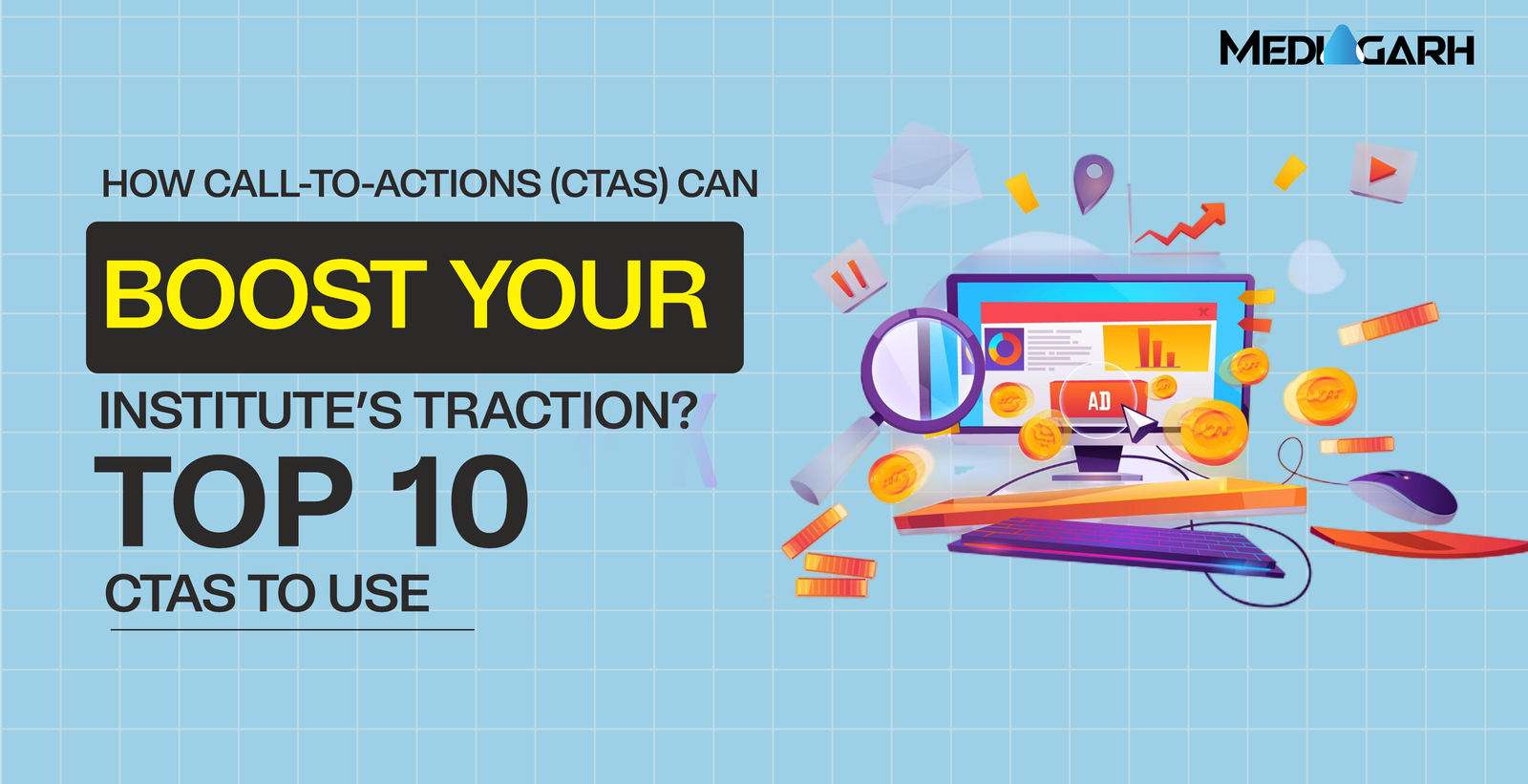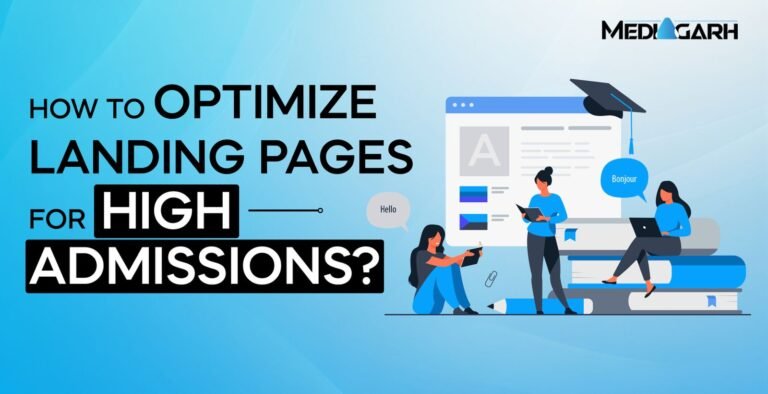Introduction
Picture the scenario of one of Mediagarh’s, best education marketing agency in India, clients just before joining: the institute’s website was receiving so much traffic that, metaphorically speaking, their servers were overloaded, and they couldn’t handle the same. Such a scenario is the dream for institutions, but don’t get excited too early. Yes, they received traction, but the snag was that most visitors didn’t enroll, download the brochure, or didn’t do what was desired. One of the introductory questions the client was left to wonder was: how do you expect the visitors to know what the institution wants? Think about your visitors like children – they don’t know how to use your website, they don’t know what you expect them to do, and they need to be directed to do so. That’s where call-to-action (CTA) steps in, a marketing term for words or phrases designed to encourage users to take action. It is an instruction to your child-like visitor to perform a task.
The Need for CTA
- Customers Need It: Remember how the introduction labels the visitors as “child-like,” the customers identify themselves similarly. When they are scrounging through your website and salesy ad copies, if they seem to care about it, they need a button to perform the task you were pitching. Now, this is a little ironic: you can’t expect the visitors to know what you want them to tell while knowing what they want when they visit your website. It’s no wonder that a lead generation agency for colleges is hired to manage all this.
- Increased Conversions: As you noticed in the client’s scenario, there was a lot of traction but no actual “conversion,” and there was no cycle of people visiting the website and then completing an action the institute wanted them to. However, including a small CTA at the end of your copy can make all the difference, directing people to web pages to complete an action such as registering for a newsletter or enrolling in a course.
- Core Sales Principle: CTA is a newly coined term, but the practice isn’t very modern; it has always been like this. After all, what is sales? Selling your products or services. So, it is rational to make such efforts (CTA in this case) to help you bring more sales and the traction coming your way to being converted to beneficial use.
General Guide to Write Over-The-Top CTAs
In CTAs or any aspect of marketing, there’s no strict essential recipe to create a mind-blowing copy. However, similar to how every component has a standardized procedure that is followed, researchers tried to standardize CTA with the LIFT model.
- Value Proposition: In the model author’s words, this element of the LIFT model is concerned with the value you are providing with your product or service. When you get down to it, conversion is the positive difference between customer-perceived benefits and costs. Is the CTA offering something valuable to the visitor? Is there a benefit of them clicking it? If yes, congratulations, you have figured out the central theme of CTAs.
- Relevance: This drives conversions in bulk. No one clicks on unknown buttons. Instead, people try to avoid them. Always maintain relevancy through all your CTAs. CTA should always ask to perform a task the visitor is looking for and the copy highlighted. For example, if a visitor came through your site looking to sign up for a newsletter, there’s no rationale in displaying a CTA that asks to buy a course.
- Clarity: No one loves half-disclosure and jargon, which includes your site visitors. Be transparent with everything, ranging from the web copy to CTAs. The CTA should clearly state what the institute wants the visitor to do and what the visitor gets in return, highlighting the value proposition. For example, a CTA for downloading a brochure should strictly highlight “Download the brochure!”
- Urgency: The author breaks down urgency into internal and external. Internal urgency is the pre-existing urgency that a visitor brings to the site, while external urgency stems from the influence of the copy. For example, internal urgency occurs when a user visits a college’s website just before the admission forms are about to be closed. However, to create an external urgency in the same situation, you might add a CTA like “Register now! Few seats left.” Only the latter is controllable, so we should enhance it, which could make a significant difference.
- Anxiety: Just as people avoid clicking unknown buttons, everyone is a little scared while scrolling online. Multiple scams take place digitally every minute. People find it comforting if you assure them of the safety of clicking buttons. Prompts such as “No Credit Card Required” or “Data Encrypted” are evidential to reduce anxiety.
- Distraction: Remember that bringing conversions was our goal from the start. We don’t want people wandering off here & there on the site like they were doing before. Reducing distractions is a dominant inhibitor of conversions. Placing ads in the wrong place or making the site cluttered are some of the pitfalls you are bound to fall into.
Top 10 CTAs
- Enrollment
This might be the most used CTA by educational institutions. The goal is to bring the highest number of course enrollments, equal to sales for other businesses, the primary growth metric. CTAs such as “Apply Now for Fall 2024 Admissions” are used.
- Information Request
Pursuing an educational course is an act of resistance since it requires a long commitment, so visitors actively seek more information about the course. CTAs such as “Request More Information About Our Programs” are bound to be counted as a conversion.
- Event Registration
Educational institutions keep conducting webinars, open house events, campus tours, etc., to promote themselves by giving a hands-on experience. Such events are targeted with CTAs highlighting subjects such as “Join our Virtual Open House!”
- Content Download
Free downloadable resources such as e-books, brochures, and book notes are highly appealing to users, and they offer you their e-mail in return for downloading, again a conversion for the institute. Text such as “Download our MBA Program Brochure” are an excellent way to promote this.
- Engagement
Want a personal connection with your (potential) visitors, and you publish a newsletter to accomplish that? Add a CTA such as “Subscribe to Our Monthly Newsletter Updates” to convert your visitors to newsletter subscribers.
- Interactive Experience
Technology has evolved unexpectedly, allowing visitors to take a virtual campus tour to observe your infrastructure and the campus facilities you offer. A simple “Take a Virtual Tour of Our Campus” on the web page will do the job.
- Consultation
Choosing an educational pursuit can be tricky. To tackle the resistance and to promote admissions, institutes offer free consultation services with admission counselors. Make use of “Schedule Your Admissions Consultation” to record a conversion.
- Free Trial/Resource
Everyone loves some free exclusive content to estimate the degree of the course. As an eventual step, institutes offer free course content beforehand for some payment details. Add a “Start Your Free Trial Today” CTA to your website and get some conversions in the books.
- Call Back
Institutes arrange callbacks to schedule the call in the visitor’s free time and to save on the visitor’s money. This way, they can convince the visitors to make a transaction. Use a “Request a Call Back” to make a difference in conversions.
- Support
Humans are curious beings with multiple queries for a single thing, and the same applies to admissions. Visitors have numerous queries that can be addressed with a “Contact Us for Admission Inquiries” CTA.
Conclusion
Call-to-actions (CTAs) are an easy way to create conversions for an already traction-heavy website and get some actual change in the institute’s metrics. But this can be daunting: navigating through so many guidelines for creating a CTA and crafting a good CTA. Let the best education marketing company in India cover your back. You can then continue to make a positive impact on the world.










